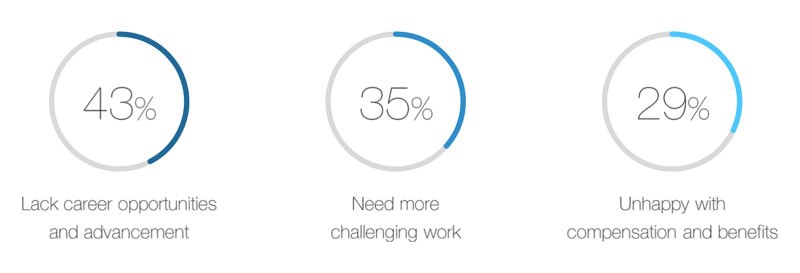5 Things You Should Do to Get Your Employees to Stay Longer
In a recent survey by Deloitte, 78% of business leaders ranked employee retention as important or urgent. Yet, earlier this year the Department of Labor reported that employee turnover is at its highest level since 2008. Clearly, employers retention efforts are failing. But why?
The why is that many companies retention efforts focus too much on compensation, benefits and bonuses and not the other reasons for leaving that surface during exit interviews.
For the past thirty years, I’ve listened to why employees are seeking another opportunity and I’ve consistently heard the same reasons. And, a recent Talent Trends report by LinkedIn backs the top three reasons I’ve found people leave jobs. Interestingly, while money and benefits are always a consideration, they aren't at the top of the list, which is:
- Lack of career opportunities and advancement
- Need more challenging work
- Unhappy with compensation
- Issues with management
- Unclear expectations
- No work life balance
Here’s how the top three reasons break down, according to LinkedIn’s survey:
The good news is, by understanding and addressing each of these issues, companies can more successfully retain their talent. Outside of increasing compensation and improving benefits, here’s what you need to do to keep your employees aroung longer:
1. Set clear expectations during the hiring process
Often expectations are not addressed during or after the hiring process. Employees want to understand what they can expect from their manager and what their manager expects from them. Not knowing daily expectations leads to frustration and job dissatisfaction.
Providing expectations during the interview and after the hiring process can resolve this issue.
2. Make sure the job description is up to date and portrays the role realistically
Too often job descriptions have not been updated and as a result, the actual job is not what was described during the interview process. Another scenario is when one specific area of responsibility represents a large portion of the job, and that specific area is not the work the employee enjoys.
To avoid this, use percentages when describing the functions of the job and also use percentages during the interview to provide a clear understanding of the job and skills of the employee. This greatly assists in the matching process.
During performance reviews, ask if the employee has any other talents that they are not utilizing in their job. Often the talents uncovered also greatly benefit the employer.
3. Identify and resolve when employees don’t mesh well with their managers
Many individuals quit their boss vs. their company. This is true when the personality, core values or style of a specific manager does not align with the employee. In other instances, the employee feels their direct manager is actually holding them back in their career.
Allowing the employee to be evaluated by others than their direct employer can open up communication to identify and resolve the mismatch. It is also important to provide leadership development to improve the management capabilities of supervisors.
4. Give employees the opportunity to learn and advance
Many employees feel stagnant without an opportunity to advance their knowledge and skills. They often mention the knowledge they have and would have like to share with others.
Providing consistent training and involving employees in presenting training provides them with the opportunity to increase their knowledge.
In general, individuals want to learn new things and advance whether it is an upward move or a lateral move with additional responsibilities. Many individuals resign when they are capable of taking on more responsibilities, but not given the opportunity.
Challenging employees to take on additional responsibilities and learn new things is critical if they are to be retained.
5. Provide flexible work hours and encourage work life balance
Not everyone “lives to work” like the Baby Boomer generation and prefer to work to live. If working hours are extended without additional time off, or if extra effort is not appreciated, this leads to turnover.
The ability to work virtual or have flexible hours is often more desirable than increased compensation. If extra hours are worked, the effort needs to be recognized.
It can be difficult to determine what improves retention even if your company is committed to improving employee engagement. Review the information shared during exit interviews and make changes so you can retain your top talent.
Your employees could be driven by different motivators than you, which is why it’s critical to see your company through their eyes. This outside/in approach will help you take the necessary steps to apply techniques that will create a great working environment which will improve retention.
To receive blog posts like this one straight in your inbox, subscribe to the blog newsletter.
Topics: Employee retention
Related articles





